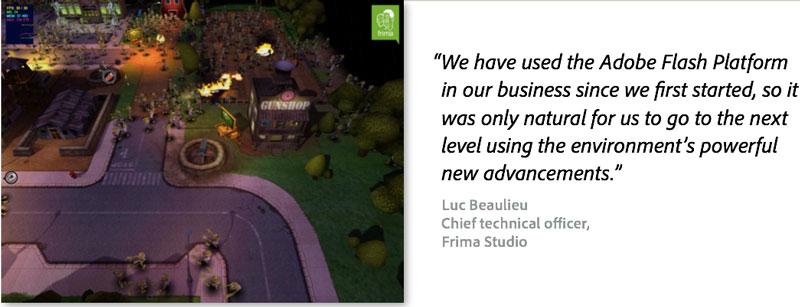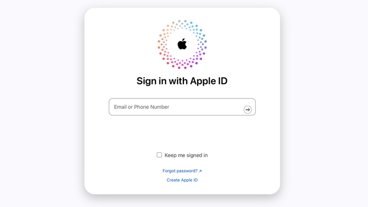Adobe promises 'console quality' games on iPhone, iPad with cross-platform AIR 3
Adobe said its latest AIR and Flash Player software will offer developers support on a range of platforms, though because Flash is not allowed on iOS, it will be restricted to the new AIR 3. In addition to iOS, the new software will support Apple's Mac OS X, Google Android, RIM BlackBerry, Microsoft Windows, connected TVs and other platforms.
Flash Player 11 and AIR 3 have been declared by Adobe to be the "game console for the Web," as they will allow 2D and 3D games to be played over the Internet on "nearly all PCs and many other devices."
"With this milestone release Adobe pushes the envelope of what is possible on the Web with a typical PC and opens up a new world of immersive, high-performance gaming experiences," said Danny Winokur, vice president and general manager of Platform at Adobe.
"Flash offers the best way for content owners to deliver their most demanding experiences, including games, premium video and sophisticated data-driven apps, to all of their users, while HTML 5 tools such as Adobe Edge and Dreamweaver are ideal for building interactive Web pages, rich ads, branded microsites and general-purpose mobile applications."
Flash Player 11 and AIR 3 will be publicly available in early October, while Flash Builder and Flex — Adobe's open source framework for building mobile, Web and desktop apps — are scheduled to receive updates to support the new features before the end of the year.
Features of Flash Player 11 and AIR 3 highlighted by Adobe include:
- Accelerated 2D/3D Graphics: Full hardware-accelerated rendering for 2D and 3D graphics enable 1,000 times faster rendering performance over Flash Player 10 and AIR 2. Developers are able to animate millions of objects with smooth 60 frames per second rendering and deliver console-quality games on Mac OS, Windows and connected televisions. A pre-release brings these same accelerated 2D and 3D capabilities to mobile platforms including Android, Apple iOS and BlackBerry Tablet OS. A production release for mobile platforms is expected in the near future. For examples of 3D games for Flash Player, visit adobe.com/go/gaming.
- AIR Native Extensions: With support for thousands of highly-optimized, open-source libraries, developers are able to tap into unique software and hardware capabilities including access to device data, vibration control, magnetometers, light sensors, dual screens, near field communications (NFC) and more. Native extensions also allow developers to more deeply integrate AIR applications with other business software.
- Captive Runtime: Developers can automatically package AIR 3 with their applications to simplify the installation process on Android, Windows and Mac OS in addition to Apple iOS. Users no longer have to download and update AIR separately on any of these platforms, or BlackBerry Tablet OS, which includes AIR built in. In addition, with the captive runtime option developers can manage version updates to their application independent of general AIR updates by Adobe.
- Content Protection: Premium video content can now be protected using Adobe Flash Access 3 across all supported platforms, including new support for mobile platforms.
- HD Video Quality Across Platforms: Full frame rate HD video can now be displayed within AIR applications on Apple iOS devices using H.264 hardware decoding. Rich applications on televisions are also able to deliver HD video with 7.1 channel surround sound.
- Rental and Subscriptions Support: With support for Adobe Flash Access and Adobe Pass, content publishers can take advantage of rental and subscription options for more flexible business models and offer TV Everywhere content to more than 80 percent of U.S. pay TV subscribers.
- Compatibility: 64-bit support on Linux, Mac OS and Windows ensures a seamless experience with the latest 64-bit browsers.
Adobe and Apple have been at odds for years as Apple has not allowed Flash onto its iOS-powered devices, including the iPhone and iPad. Last April, Apple co-founder Steve Jobs published a letter slamming Flash as outdated technology unfit for the modern era of mobile computing.
But Apple also conceded some ground to Adobe and others last September when it began allowing applications in its iOS App Store that were created with third-party development tools. Previously, software written in those third-party tools and ported to iOS was banned from being available on the Apple-controlled App Store.
Adobe has since moved to capitalize on Apple's concession, adding support for building iOS applications with its Flash Builder and Flex software in June. The company is also working to add support for Apple's new Newsstand application, a major feature of the forthcoming iOS 5 update, into Adobe's Digital Publishing Suite, which is used to produce digital publications for the iPad, as well as Android-powered tablets and RIM's PlayBook.
And earlier this month, Adobe announced a new version of its Flash Media Server software that would deliver video to Apple's iPhone and iPad. The updated software will add the ability for its Flash Media Server product to serve iOS-compatible HTML5 video in addition to Flash video.
 Katie Marsal
Katie Marsal











 Mike Wuerthele
Mike Wuerthele

 Malcolm Owen
Malcolm Owen
 Chip Loder
Chip Loder

 William Gallagher
William Gallagher
 Christine McKee
Christine McKee
 Michael Stroup
Michael Stroup






